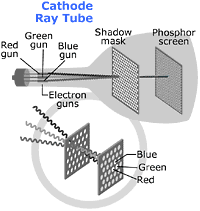|
PICTURES
IN A BOX
Despite
his unforgettable name, you've probably never heard of Philo T. Farnsworth—which
is really a shame, since he helped invent TV. And he did it when he
was just a kid. Farnsworth grew up on a farm in Idaho, but loved electronics.
In 1921, when he was 14, two new inventions caught his eye: the photoelectric
cell, which turns light into electrical signals, and the cathode ray
tube, which turns electrical signals back into light.

Farnsworth
wanted to use these inventions together. He thought he could change
a picture into an electrical signal, send the signal across a wire,
and then reassemble the picture someplace else. He had it all figured
out—except for the last step.
One day,
while plowing a field, he suddenly realized that he could "build
up" an electronic image by drawing lots of back-and-forth lines
of light—like the rows of soil he was plowing. In 1927, Farnsworth moved
to San Francisco to test his ideas, and built the first successful electronic
TV system here.
Today,
most TVs still work the way Farnsworth envisioned, making pictures by
drawing thousands of dotted lines of light back and forth across the
screen.
|

|

|

|
Dot-to-Dot
Pictures
To
do this activity, you'll need:
newspaper pictures
a magnifying glass
a turned-on TV
a few drops of water
|
Use
your magnifying glass to look closely at a photo in the newspaper.
See all the little dots?
Now
dip your fingers in the water and spray a few drops onto a TV
screen. The drops will act like tiny magnifying lenses. Look closely
and you'll see that the picture on the TV is made up of dots,
too.

What'
s
going on?
Even
though your eyes see patterns of dots, your brain has no trouble
recognizing them as pictures. That's because your brain is always
trying make sense of the things you see. As long as the dots
are the right size and spacing, your brain will be able to blend
them together and recognize the picture they make.
Pictures
made from dots don't just show up in newspapers and on TV. Check
out the pictures in books, magazines, and even on movie and
computer screens.
|
|